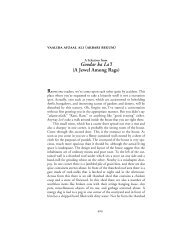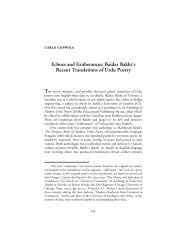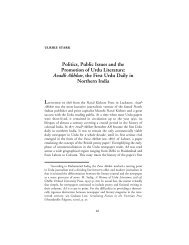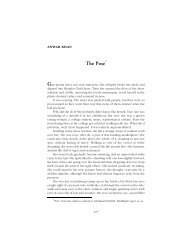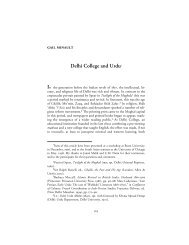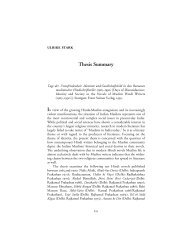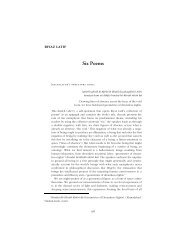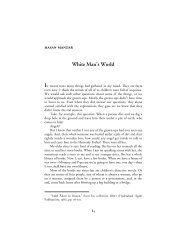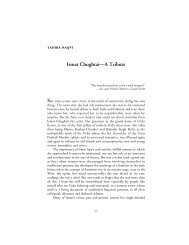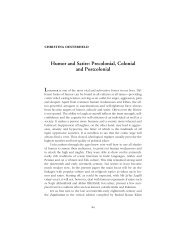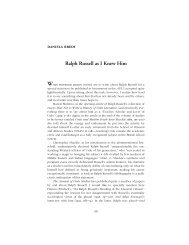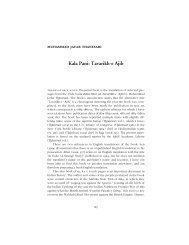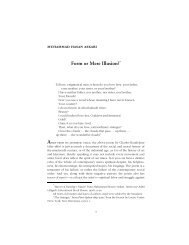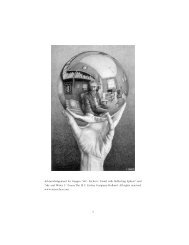Premchand's âShatranj ke Khilariâ in Translation - the Annual of Urdu ...
Premchand's âShatranj ke Khilariâ in Translation - the Annual of Urdu ...
Premchand's âShatranj ke Khilariâ in Translation - the Annual of Urdu ...
You also want an ePaper? Increase the reach of your titles
YUMPU automatically turns print PDFs into web optimized ePapers that Google loves.
208 • The <strong>Annual</strong> <strong>of</strong> <strong>Urdu</strong> Studies, No. 28<br />
Nuʿmānī believed Premchandís <strong>Urdu</strong> usage was above par (Rai 2002 106),<br />
and br<strong>in</strong>gs <strong>in</strong>to play <strong>the</strong> veracity <strong>of</strong> l<strong>in</strong>guistic usage <strong>in</strong> regard to his target<br />
languageó<strong>the</strong> idea that <strong>the</strong> question <strong>of</strong> <strong>the</strong> language <strong>in</strong> his translations is<br />
thorny (Rub<strong>in</strong> 1988, 261) and that he <strong>of</strong>ten assigned translations <strong>of</strong> his stories<br />
to his pupils/collaborators, which he later touched up (Gopal 1964,<br />
113). Pritchett po<strong>in</strong>ts out that Premchandís <strong>Urdu</strong> terms sound ìromanticî<br />
(1986, 69). This is primarily because <strong>the</strong> <strong>Urdu</strong> language ma<strong>in</strong>ta<strong>in</strong>s its resplendent<br />
poetic traditions <strong>in</strong> its fictional usage. It is perhaps, because <strong>of</strong> its<br />
copious, elegiac, rhythmic and lyrical style that <strong>the</strong> <strong>Urdu</strong> text seems less<br />
ironic and cynical, even <strong>in</strong> its satiric descriptions. That ìShatranj ki Baziî<br />
was published <strong>in</strong> a collection entitled Khvāb-o-Khayāl kī Kahāniyāñ may<br />
also have had some bear<strong>in</strong>g on <strong>the</strong> tone and tenor <strong>of</strong> <strong>the</strong> <strong>Urdu</strong> text.<br />
“Shatranj <strong>ke</strong> Khilari” and “The Chess Players”<br />
David Rub<strong>in</strong>ís translation <strong>of</strong> <strong>the</strong> H<strong>in</strong>di ìShatranj kē Kẖilāṛīî as ìThe Chess<br />
Playersî was not part <strong>of</strong> his first, 1969, selection <strong>of</strong> Premchand stories. However,<br />
he <strong>in</strong>cluded it, along with five o<strong>the</strong>r stories, <strong>in</strong> his second, revised and<br />
expanded edition <strong>of</strong> 1988. These additions were meant to illustrate <strong>the</strong> broad<br />
range <strong>of</strong> Premchandís genius and <strong>the</strong> scope <strong>of</strong> his appeal (Rub<strong>in</strong> 1988, 11).<br />
He had <strong>in</strong>tended this edition for Indian readership as well as for Anglophone<br />
readers outside India (ibid., 12), to whom nei<strong>the</strong>r <strong>the</strong> authorís language<br />
nor <strong>the</strong> cultural significations <strong>of</strong> <strong>the</strong> story are o<strong>the</strong>rwise <strong>in</strong>telligible.<br />
Thus, Rub<strong>in</strong>ís cross-cultural translation <strong>in</strong>tends to acqua<strong>in</strong>t a l<strong>in</strong>guistically<br />
and culturally diverse readership with Premchandís world and thought.<br />
Rub<strong>in</strong>ís translation is centered on Fishmanís formulation <strong>of</strong> <strong>the</strong> pr<strong>in</strong>ciples<br />
<strong>of</strong> sociol<strong>in</strong>guistics which may be extended to view translational exercises as<br />
center<strong>in</strong>g on notions <strong>of</strong> who translates for whom, where and why (Gupta<br />
1997, 185).<br />
Rub<strong>in</strong> ma<strong>ke</strong>s use <strong>of</strong> several translational techniques and devices <strong>in</strong><br />
order to achieve textual, psychological, cultural and aes<strong>the</strong>tic equivalence.<br />
Although absolute exactness is elusive, his translation achieves equivalence<br />
<strong>in</strong> that it reta<strong>in</strong>s Premchandís message, and aims to produce similar effects<br />
upon <strong>the</strong> reader. Rub<strong>in</strong> negotiates various l<strong>in</strong>guistic and cultural patterns<br />
<strong>of</strong> <strong>the</strong> source language text <strong>in</strong> order to convey <strong>the</strong> serious <strong>in</strong>tent <strong>of</strong> Premchandís<br />
tale <strong>in</strong> <strong>the</strong> target language text. This is largely because <strong>the</strong> English<br />
language short story does not operate s<strong>in</strong>gularly on <strong>the</strong> device <strong>of</strong> irony<br />
and/or sarcasm <strong>in</strong> order to convey a serious, utilitarian message, if at all, it<br />
has one. Premchandís irony, conveyed by means <strong>of</strong> his tone and vocabulary<br />
is <strong>the</strong> ma<strong>in</strong>-stay <strong>of</strong> his narrative, promulgat<strong>in</strong>g his political message. Per-



